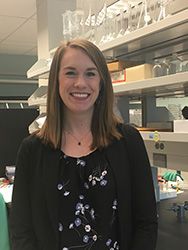Graduate Student Award Winner Presents at NY–NJ SAS May On-line Meeting on Utilizing Raman Spectroscopy and Machine Learning for Medical Diagnostics
The New York and New Jersey Regional Section of the Society for Applied Spectroscopy (NYSAS) held an on-line meeting on Wednesday, May 27. The speaker, Nicole Ralbovsky, was selected as the 2020 NY–NJ SAS Graduate Student Award winner. Ralbovsky is a fourth-year doctoral candidate in Igor K. Lednev’s laboratory at the University at Albany, SUNY.
Nicole Ralbovsky

The New York and New Jersey Regional Section of the Society for Applied Spectroscopy (NYSAS) held an on-line meeting on Wednesday, May 27. The speaker, Nicole Ralbovsky, was selected as the 2020 NY–NJ SAS Graduate Student Award winner. Ralbovsky is a fourth-year doctoral candidate in Igor K. Lednev’s laboratory at the University at Albany, SUNY.
Ralbovsky’s presentation discussed the use of machine learning modeling for non-invasive and early detection of several diseases simply by using the Raman fingerprint of biological fluids. To address the growing need for fast, non-invasive diagnostic tools that are also sensitive and selective, Raman spectroscopy, in combination with machine learning, is the focus of research by many of Lednev’s students at SUNY Albany, The combination of Raman spectroscopy and genetic algorithms has been applied for analyzing several different diseases including Alzheimer’s disease, Duchenne muscular dystrophy, and Celiac disease in proof-of-concept studies. In each case, Raman spectral data were collected from biological samples of healthy and diseased donors. Machine-learning algorithms were built and validated, each achieving >95% diagnostic accuracy. The studies reported support the hypothesis that Raman spectroscopy, in combination with machine-learning analysis, has enormous potential and is gaining support by the medical community as a minimally invasive, accurate, and rapid universal medical diagnostic method.
Ralbovsky’s specific research focuses on applying this combination of Raman spectroscopy and machine learning for detecting Alzheimer’s disease, Celiac disease, muscular dystrophy, and diabetes. She has three first-author manuscripts published, one under review, and two more submitted for review, with others in progress (1–5).
She received an RNA Society fellowship awarded by SUNY Albany and funded by the National Institutes of Health (NIH) to pursue this research.
In addition to the progress she has made regarding her research, Ralbovsky has maintained an overall 4.0 grade-point average (GPA) and was the two-time recipient of SUNY Albany’s Harry L. Frisch Memorial scholarship in Chemistry, and the Lawrence and Marie Shore Graduate Scholarship in Life Sciences as a result of her academic achievements. She received the 2019 Coblentz Society student award, was an invited symposium speaker at Pittcon 2019, received the Ford Foundation Initiatives for Women in Science Fellowship, and has been the recipient of ten different travel awards, which have resulted in 13 presentations at various conferences and symposia. Additionally, Ralbovsky spends time participating in SUNY Albany’s Graduate Student Club for Chemistry, where she is the secretary, SUNY Albany’s Graduate Student Association, and she volunteers with the Alzheimer’s Association and her local church.
With the help of Chris Brais, the social media chair for the national society, the NYSAS regional section advertised the meeting using a variety of social media venues, and got an excellent turnout. In total, a 45 people participated, including many new attendees from within and outside the section’s geographic region and also from outside country. The NY–NJ SAS regional section will continue to offer meetings on-line for all members who want to participate. Anyone with feedback or who would like to join an on-line meetings, may send an email to debperu@outlook.com to receive a link to the next virtual session.
More information about the NY–NJ SAS organization, including the past and future meeting schedule is available at www.nysas.org.
References
- N.M. Ralbovsky, L. Halámková, L., K. Wall, C. Anderson-Hanley, I.K. Lednev, I J. Alzheimer's Dis., 71 (4), 1351–1359 (2019).
- N.M. Ralbovsky, I.K. Lednev, Spectrochimica Acta Part A: 519, 463–487 (2019).
- N.M. Ralbovsky, V. Egorov, E. Moskovets, P. Dey, B.K. Dey, I.K. Lednev, Cancer Studies and Molecular Medicine Open Journal 5 (1), 1–10 (2019).
- N.M. Ralbovsky, P. Dey, A. Galfano, B.K. Dey, I.K. Lednev, Scientific Reports 2020, In Press.
- E. Ryzhikova, N.M. Ralbovsky, L. Halamkova, D. Celmins, P. Malone, E. Molho, J. Quinn, E.A. Zimmerman, I.K. Lednev, Applied Sciences 9(16), 3526 (2019).
New Fluorescence Model Enhances Aflatoxin Detection in Vegetable Oils
March 12th 2025A research team from Nanjing University of Finance and Economics has developed a new analytical model using fluorescence spectroscopy and neural networks to improve the detection of aflatoxin B1 (AFB1) in vegetable oils. The model effectively restores AFB1’s intrinsic fluorescence by accounting for absorption and scattering interferences from oil matrices, enhancing the accuracy and efficiency for food safety testing.
New Study Shows FT-MIR Spectroscopy Can Authenticate Parmigiano Reggiano Farming Practices
March 11th 2025A new study published in the Journal of Dairy Science demonstrates that FT-MIR spectroscopy can effectively authenticate farming practices and dairy systems in Parmigiano Reggiano production but has limited ability to verify animal welfare parameters.
Advancing NIR and Imaging Spectroscopy in Food and Bioanalysis
March 11th 2025Our full-length interview with Huck covers more than just NIR spectroscopy in food and bio analysis. Spectroscopy sat down with Huck to also discuss current trends going on in spectroscopy, delving into what challenges spectroscopists face today and how they can solve these concerns.
The State of Forensic Science: Previewing an Upcoming AAFS Video Series
March 10th 2025Here, we provide a preview of our upcoming multi-day video series that will focus on recapping the American Academy of Forensic Sciences Conference, as well as documenting the current state of the forensic science industry.